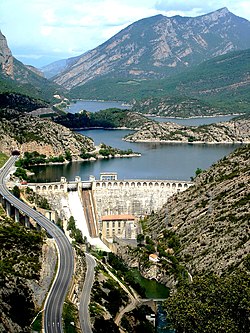Oliana
 From Wikipedia - Reading time: 9 min
From Wikipedia - Reading time: 9 min
This article has multiple issues. Please help improve it or discuss these issues on the talk page. (Learn how and when to remove these messages)
|
Oliana | |
|---|---|
 | |
| Coordinates: 42°04′N 1°19′E / 42.067°N 1.317°E | |
| Country | |
| Community | |
| Province | Lleida |
| Comarca | Alt Urgell |
| Government | |
| • Mayor | Carme Lostao Otero (2019) |
| Area | |
• Total | 32.4 km2 (12.5 sq mi) |
| Elevation | 469 m (1,539 ft) |
| Population (2018)[1] | |
• Total | 1,787 |
| • Density | 55/km2 (140/sq mi) |
| Website | oliana |
Oliana (Catalan pronunciation: [oliˈanɛ]) is a municipality in the comarca of the Alt Urgell in Catalonia, Spain. It is situated in the Segre valley immediately below the Oliana reservoir. There is a factory of domestic electrical appliances in the town, and the presence of non-farming employment has meant that Oliana has escaped the depopulation experienced by most municipalities in north-west Catalonia. It is currently the second-largest town (by population) in the Alt Urgell, behind the comarcal capital La Seu d'Urgell. The town is served by the C-14 road between Ponts and La Seu d'Urgell.
Demography
[edit]| 1900 | 1930 | 1950 | 1970 | 1986 | 2005 |
|---|---|---|---|---|---|
| 986 | 1127 | 1793 | 1793 | 2075 | 1932 |
Subdivisions
[edit]The municipality of Oliana includes two outlying villages. Populations are given as of 2001:
- Les Anoves (27)
- El Castell (73)
Climbing
[edit]The region is well known among rock climbers for its extremely difficult limestone cliffs, including La Dura Dura ("the hardest of the hard"), which is one of the hardest climbs successfully undertaken in the world.
References
[edit]- ^ Municipal Register of Spain 2018. National Statistics Institute.
- Panareda Clopés, Josep Maria; Rios Calvet, Jaume; Rabella Vives, Josep Maria (1989). Guia de Catalunya, Barcelona: Caixa de Catalunya. ISBN 84-87135-01-3 (Spanish). ISBN 84-87135-02-1 (Catalan).
External links
[edit]- Government data pages (in Catalan)
 KSF
KSF
